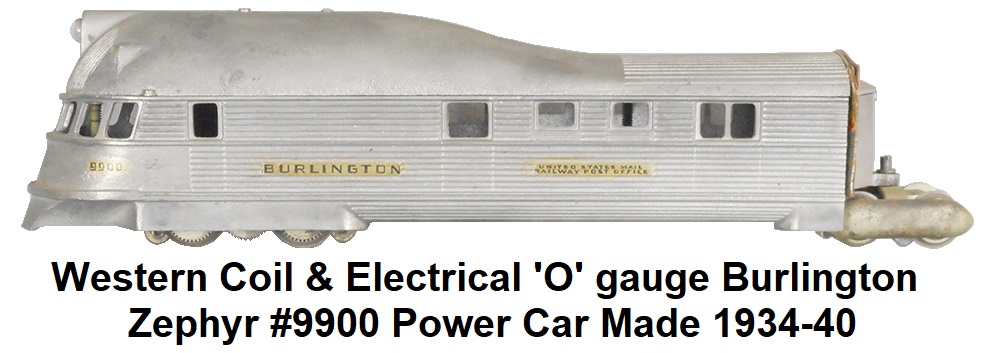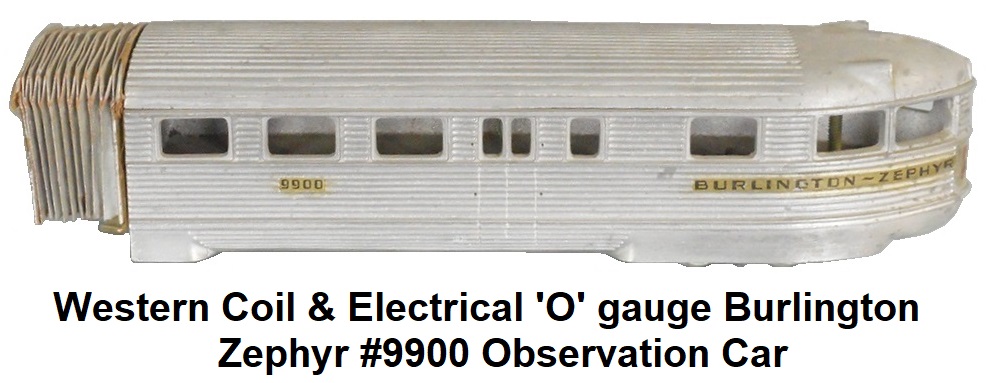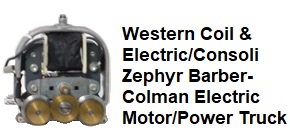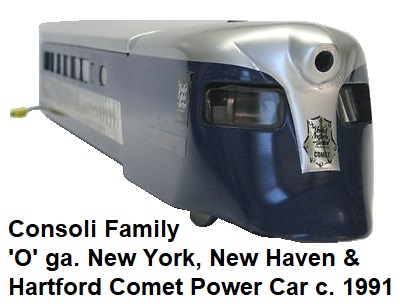The Western Coil & Electrical Company of Racine, Wisconsin was founded in 1915 by
William Turnor Lewis (1896-1979) and his father. The company's primary business was manufacturing radios. In 1920 they made
the Western Coil Type A crystal radio and later created the Radiodyne brand. In the 1930's, for some reason that has always
been a mystery, the company decided to produce an 'O' scale toy train. The train was an operating model of the famous
shovel-nosed Burlington Zephyr streamliner, and was the only toy train that Western Coil & Electrical ever produced. The set
box label identified it as 'The West Wind.' Western Coil & Electrical also produced their own brand of 3-rail tubular 'O'
gauge and Standard gauge sectional T-track called Tru-Trak, and a device for sequencing the running of several electric
trains on the same track system called the Midget Dispatcher.



It is believed that the decision to enter the toy train market was most likely an attempt to improve
business by branching out into a new line of products that were becoming widely popular in American homes during this
period. There were several well-known competing companies in the mid-1930's toy train market such as
Lionel, American Flyer, Marx, Dorfan,
Hafner, Hoge, Scale-Craft,
Lobaugh and Walthers. Western Coil & Electrical's approach was to offer
a well-made train with a variety of options to appeal to this rapidly growing marketplace. Their Burlington Zephyr was made
from sand cast aluminum. It was offered in 3-car sets that consisted of a #9900 Burlington United States Mail Railway
Express Agency Post Office power car, Railway Express Agency Pullman center car and an Observation trail car. The lead car was
powered using Barber-Colman unidirectional motors. Vestibules (bellows) between the cars were made from heavy paper. Deluxe
sets featured metal handrails and window panes applied to the outside of the car bodies. The Zephyr was marketed
as complete ready-to-run or in kit form and could be purchased with finished castings or for a lesser amount, with
unfinished castings that the modeler would have to file and finish themselves. To satisfy scale modelers, the Zephyr could be
configured to operate using outside 3rd rail scale electrical pick-up, a popular trend from that era, or for the more
traditional 3-rail operation on 'O' gauge track, the train had roller-type pickups.
 The bodies of the cars are one-piece castings. The Zephyr lead power car had an operating headlight
and two marker lights located on each side of the headlight. The Pullman and Observation cars had interior lighting, and the
Observation car had 2 red marker taillights and one back-up light on the rear. The motor was secured to the power car body
via a cotter pin that went through a fitting that extended through the rooftop of the body. The instructions for the Western
Coil & Electrical Zephyr state that the trains should be operated normally at 10-12 volts AC. More voltage than that can
potentially burn out the electric motor.
The bodies of the cars are one-piece castings. The Zephyr lead power car had an operating headlight
and two marker lights located on each side of the headlight. The Pullman and Observation cars had interior lighting, and the
Observation car had 2 red marker taillights and one back-up light on the rear. The motor was secured to the power car body
via a cotter pin that went through a fitting that extended through the rooftop of the body. The instructions for the Western
Coil & Electrical Zephyr state that the trains should be operated normally at 10-12 volts AC. More voltage than that can
potentially burn out the electric motor.
William Turnor Lewis believed that he had acquired exclusive rights to make the miniature scale models
of the Burlington Zephyr after it went into service. The Zephyr prototype was a diesel-powered trainset built by the Budd
Company in 1934 for the Chicago,
Burlington and Quincy Railroad (CB&Q), commonly known as the Burlington Route. The trainset was the second internal
combustion powered streamliner built for mainline service in the United States, the first such train powered by a diesel
engine, and the first to enter revenue service. The trainset consisted of one power/RPO car, one baggage/buffet/coach car,
and one coach/observation car. The cars were constructed with stainless steel, permanently articulated together with Jacobs
bogies. The construction incorporated recent advances such as shotwelding (a specialized type of spot welding) to join the
stainless steel, and unibody construction and articulation to reduce weight. The Pioneer Zephyr was the first of nine
similarly built trainsets made for Burlington and its technologies were pivotal in the subsequent dieselization of passenger
rail service. Its operating economy, speed, and public appeal demonstrated the potential for diesel-electric powered trains
to revitalize and restore profitability to passenger rail service that had suffered a catastrophic loss of business with the
Great Depression. Originally named the Burlington Zephyr during its demonstration period, it became the Pioneer Zephyr as
Burlington expanded its fleet of Zephyr trainsets. On May 26, 1934, it set a speed record for travel between Denver and
Chicago when it made a 1,015.4-mile (1,633 km) non-stop 'Dawn-to-Dusk' dash in 13 hours 5 minutes at an average speed of
almost 78 mph (124 km/h). For one section of the run it reached a speed of 112.5 mph (181 km/h). The historic dash inspired
a 1934 film and the train's nickname, 'The Silver Streak'. The train entered regular revenue service on November 11, 1934,
between Kansas City, Missouri, Omaha, Nebraska, and Lincoln, Nebraska. It operated this and other routes until its retirement
in 1960, when it was donated to Chicago's Museum of Science and Industry, where it remains on public display. The train is
generally regarded as the first successful streamliner on American railroads.

Western Coil & Electrical had already been making and selling its Tru-Trak products prior to producing the
Zephyr. Tru-Trak featured insulation on all 3 rails, and was somewhat realistic in its
appearance as ties made of a wooden material were spaced along the entire length of the rails. The rails were formed
in a prototypical 'T' rail shape and fastened to the ties via small nails that looked like rail spikes. The material
used for the rails was a steel alloy - extruded aluminum. Track sections were joined using actual U-bolts, fish plates and
nuts. The company
claimed in its brochures that trains ran smoother on their Tru-Trak, had better electrical connectivity and that it was rust
proof, and sturdier than track available from its competitors. They declared the track was so strong it could be stepped on
without damaging it. The Tru-Trak was available in straights, curves, 90° crossings and remote controllable switches.
The switch tracks were equipped with an automatic locking feature that the company claimed would allow, "a fast moving train
to be driven through the switch points at high speed without danger of derailment".
The Zephyrs were produced from 1934 to 1940. Western Coil & Electric stopped making radios in 1932.
After 1932, they sold Well-Gardner radios with the Western Coil brand, and manufactured electrical devices, TV towers and
many plastic toys. Evidently they also manufactured balsa-wood model airplane kits with plastic accessories under the name
of Hobby-Time in the post-war 1940's-50's. The company was sold in 1978, moved to Milwaukee and renamed Plastic
Specialties.

In 1978, Antonio Consoli of Wayne, NJ, purchased the original molds, tools, and parts inventory of the
Western Coil & Electrical Company's Burlington Zephyr Division, but not for the reasons you would think. Consoli had picked
up a used Western Coil & Electrical 1930's Zephyr set at the October 1977 York, PA TCA train meet, and discovered it was in
need of repairs. The motor was incorrect and the vestibules were missing. In an effort to acquire the needed parts, he
contacted Western Coil & Electrical via U.S. mail. To Consoli's surprise he received a response from William Turnor Lewis
himself. Turnor explained that the parts and tooling for the Zephyr had been stored away for 38 years and that
it would not be worth the time to look for just a few parts. Instead, Turnor offered to sell Consoli the entire inventory,
including the face plates, core molds and all parts. Eventually, a 1 year option was agreed on between Consoli and Lewis.
To finance the acquisition, Consoli decided to build and sell a limited number of approximately 25 2-car sets consisting
of a lead power car and an observation car exclusively to TCA members. There was enough parts inventory and original
castings available for building the 25 sets, however some replacement parts were utilized to complete the sets. The set was
priced at $150 each. Purchasers of these 2-car sets (head-end and observation car) were given the option to also acquire a
middle Pullman car to be newly cast from the original molds for an additional $25. Surprisingly, Consoli received an
excellent response to letters he sent to TCA members who had indicated an interest in 'O-72' scale trains in the TCA
Directory. Bob Thon provided Consoli with advice and encouragement, and actually purchased the
first set.

Consoli developed a small aluminum foundry in his garage. With the assistance of his sons Anthony Jr.
and John, wife Dot, and his sister-in-law's husband Don Fahrenholz, Consoli was able to build the 25 initial sets and
deliver them to the TCA purchasers in original set boxes. The sets even came with all of the original paperwork from Western
Coil, including postcards and a neat set of blueprints. Don personally cast the 25 Pullman center cars. Later on, the
Consoli family issued a Vista-Dome car that was a modification to the coach casting to make the set a 4 car consist.
Thus, the Consoli Family Train Company of Toms River, NJ was born. In 1983 when then President Ronald Reagan was asked
what he wanted for Christmas, he said he wanted a model train. Consoli sent him a Burlington Zephyr.
 The Consoli version of the Zephyr initially utilized the same Barber-Colman electric motor as the original version
made by Western Coil & Electrical. This motor was an induction type, strictly for use with AC current, and has only been
utilized in toy or model trains rarely. Induction motors do not have brushes or a commutator. The induction motor used by
Western Coil & Electrical, and subsequently by Consoli, was known as a type called a Shaded Pole induction motor. The trains
ran in one direction only. This type of electric motor is simple in appearance and less expensive to manufacture. Startup
torque is not known to be very good in these motors and RPM is limited by the line frequency (60 cycles per second or 60
Hertz). The frequency of the electricity governed the speed of these electric motors. Once the motor reached its maximum RPM,
it would not go any faster no matter how much power/voltage was applied. As a result, these motors tend to overheat easily,
especially if excess power, greater than 10-12 volts, is continuously applied by the operator. Aside from Western Coil &
Electric's Zephyr, the induction type motor was used in the General Trains Inc. Standard
gauge Union Pacific M10000 Streamliner sets made in the early 1930's.
The Consoli version of the Zephyr initially utilized the same Barber-Colman electric motor as the original version
made by Western Coil & Electrical. This motor was an induction type, strictly for use with AC current, and has only been
utilized in toy or model trains rarely. Induction motors do not have brushes or a commutator. The induction motor used by
Western Coil & Electrical, and subsequently by Consoli, was known as a type called a Shaded Pole induction motor. The trains
ran in one direction only. This type of electric motor is simple in appearance and less expensive to manufacture. Startup
torque is not known to be very good in these motors and RPM is limited by the line frequency (60 cycles per second or 60
Hertz). The frequency of the electricity governed the speed of these electric motors. Once the motor reached its maximum RPM,
it would not go any faster no matter how much power/voltage was applied. As a result, these motors tend to overheat easily,
especially if excess power, greater than 10-12 volts, is continuously applied by the operator. Aside from Western Coil &
Electric's Zephyr, the induction type motor was used in the General Trains Inc. Standard
gauge Union Pacific M10000 Streamliner sets made in the early 1930's.
By 1984 The Consoli Family Train Company of Wayne, NJ was offering 50th Anniversary Special Burlington
Zephyr sets utilizing many of the leftover original parts combined with new sandcast aluminum bodies. A 3-car set was offered
for $235, and a 4-car set was priced at $285. In 1984 Consoli purchased the United States Toy
Train Company/USTTC Trains. The acquisition was made because Consoli needed a source for electric motors, and USTTC had
previously purchased all remaining inventory stock of 700 assembled Marx double reduction motors from the Girard,
Pennsylvania plant when then Marx owner Quaker exited the toy train business. The basic Marx motor
was famous for never wearing out. In 1987 Consoli began making and selling a Flying Yankee 'O' gauge streamliner set that
sold for $275. The Consoli Family Company was now shown on advertisements and flyers as being located in Tom's River, NJ.
Consoli and his family went on to produce Zephyr sets cast in bronze in 1988 that had a gold
appearance. There were 100 of these sets offered as a 'Limited Edition' at a price of $850 to celebrate the 10th Anniversary
of the company.

 In 1992 Consoli began producing a new polished aluminum 'O' gauge casting for a blue painted version of the
Boston Providence streamliner called the Comet, liveried for the New York, New Haven & Hartford RR. The 'O' gauge model was
first shown at the Spring 1991 York, PA train show, and then again at the fall York meet. The prototype Comet was a
diesel-electric streamliner built in 1935 for the New York, New Haven and Hartford Railroad by the Goodyear-Zeppelin Company.
Smaller than the other streamliners, it was a three-car, double-ended train that could operate in both directions and thus
did not need to be turned at destinations, which was ideal for the New Haven's cramped terminus at South Station in Boston.
During its heyday, the Comet ran 6 trips a day between Providence Rhode Island and Boston.
Consoli's Comet utilized the same electric double reduction motors as the Zephyr, and also had paper diaphragms between the
cars. It was a 2-header just like the real Comet, but unlike the original, Consoli offered a 4 unit version, as well as a
prototypical 3-unit one. Each head unit was powered, and all cars had interior illumination. It is believed that only 25 of
the Comets were ever produced. Another item produced by Consoli was an 'O' gauge ZIM track cleaning car that was built to
resemble a train snow blowing car with an impellor on the front.
In 1992 Consoli began producing a new polished aluminum 'O' gauge casting for a blue painted version of the
Boston Providence streamliner called the Comet, liveried for the New York, New Haven & Hartford RR. The 'O' gauge model was
first shown at the Spring 1991 York, PA train show, and then again at the fall York meet. The prototype Comet was a
diesel-electric streamliner built in 1935 for the New York, New Haven and Hartford Railroad by the Goodyear-Zeppelin Company.
Smaller than the other streamliners, it was a three-car, double-ended train that could operate in both directions and thus
did not need to be turned at destinations, which was ideal for the New Haven's cramped terminus at South Station in Boston.
During its heyday, the Comet ran 6 trips a day between Providence Rhode Island and Boston.
Consoli's Comet utilized the same electric double reduction motors as the Zephyr, and also had paper diaphragms between the
cars. It was a 2-header just like the real Comet, but unlike the original, Consoli offered a 4 unit version, as well as a
prototypical 3-unit one. Each head unit was powered, and all cars had interior illumination. It is believed that only 25 of
the Comets were ever produced. Another item produced by Consoli was an 'O' gauge ZIM track cleaning car that was built to
resemble a train snow blowing car with an impellor on the front.
Interestingly, there seems to be another connection between General Trains Inc. and Western Coil &
Electrical. Both companies marketed a Dispatcher device. The Western Coil & Electrical product was called the Midget
Dispatcher and was first released before 1934 for a hefty price of $16.50, which was a steep price for that time. This
device featured a metal rotary drum, and via the use of paper sheets as an insulator to cover the drum, could be programmed
by placing holes strategically in the sheet so that metal finger wires would contact the drum through the holes when the drum
rotated, to close a circuit. The device could be used to control an entire
model train layout. The Dispatcher could start and stop multiple trains on the same track, raise and lower crossing gates,
animate miniature electric signs, work switch tracks, blink lights on towers, and perform other operations. The General
Trains Inc. device was marketed as the General Dispatcher and sold for $14.50. The pictures in the ads promoting each
Dispatcher are nearly identical. The General Dispatcher sports a light bulb and an inline switch while the Midget Dispatcher
has no light and looks to have a separate switch mechanism. This was a very complicated device that came with a 16 page
instruction booklet. It is believed that the device was actually designed by General Train's Harry C. Stearns, who applied
for a patent in 1932 (approved in 1936). However, it is also believed that Western Coil & Electrical actually built the
devices, perhaps for General Models Inc. There is speculation that since Racine, WI, the home of Western Coil & Electrical,
is just across the Illinois border a short 80 miles from Chicago, where General Trains Inc. was located, that it is possible
the two companies had some direct interaction.
Both the Western Coil & Electrical and the Consoli Family Zephyr models are sought after by collectors.
In documented communications, William Turnor Lewis indicated that there were less than 1000 Zephyrs produced by Western Coil
& Electrical in the 1930's, making them quite rare today. The W.C.& E. versions typically sell for a higher price, when they
can be found. The company faced a large challenge from its competitors, especially from American Flyer who issued their
version of the Zephyr around the same time, but at a lower price point, and with less detail. Lewis claimed that when the
competition came out with their products, he received multiple cancellations for orders he had taken, thus causing a huge
loss of revenues for these products. Ultimately, this competition and undercutting of prices drove the company to discontinue
Zephyr sales and the product line. In March of 1991 Antonio Consoli sold the dies and rights to the Zephyr and the Flying
Yankee. He passed away in 1992. Bob Thon, who was owner of Robert Lines beginning in 1978,
had purchased the first ever produced Comet at a York, PA meet, and was a good friend of the Consoli family, ended up
acquiring the leftover parts for the Comet.
Sources of information for the history of Western Coil & Electrical/Antonio Consoli used here include:
The Train Collectors Quarterly January 2007, Volume 53, No. 1, article "Western Coil and Electrical's Burlington Zephyr", by
Ronald T. Sinkule.
The Train Collectors Quarterly October 1969, Volume 15, No. 4, Letter to Lou Redmond from W. Turnor Lewis, President of
Western Coil & Electrical
The Train Collectors Quarterly October 1986, Volume 32, No. 5, article "Western Coil & Electric Burlington Zephyr and Me", by
Tony Consoli
The Train Collectors Quarterly April 2009, Volume 55, No. 2, article "The General Dispatcher Does Exist... Well, Kinda..." by
Arno Baars
Wikipedia.org
Back To Top of Page

